包阅导读总结
1. `Node.js`、`Express.js`、`MongoDB`、`应用构建`、`服务器端`
2. 本文主要介绍如何使用 Node.js、Express.js 和 MongoDB 构建应用程序,包括设置项目、创建服务器、渲染动态页面、连接数据库、创建模型和表单页面等步骤。
3.
– 介绍 Node.js 是运行 JavaScript 代码的服务器端运行环境,适用于创建快速可扩展的应用。
– 以简单事件管理应用为例,展示构建过程。
– 构建步骤
– 前置准备
– 安装 Node.js 和 npm,初始化新项目。
– 设置服务器
– 创建 server.js 文件。
– 安装并设置 Express.js。
– 创建动态模板
– 安装 ejs 模板引擎。
– 保存数据到 MongoDB
– 介绍 MongoDB 特点。
– 连接到数据库。
– 使用 Mongoose 连接。
– 创建文档模型 Schema。
– 创建 HTML 页面
– 创建表单页面。
思维导图: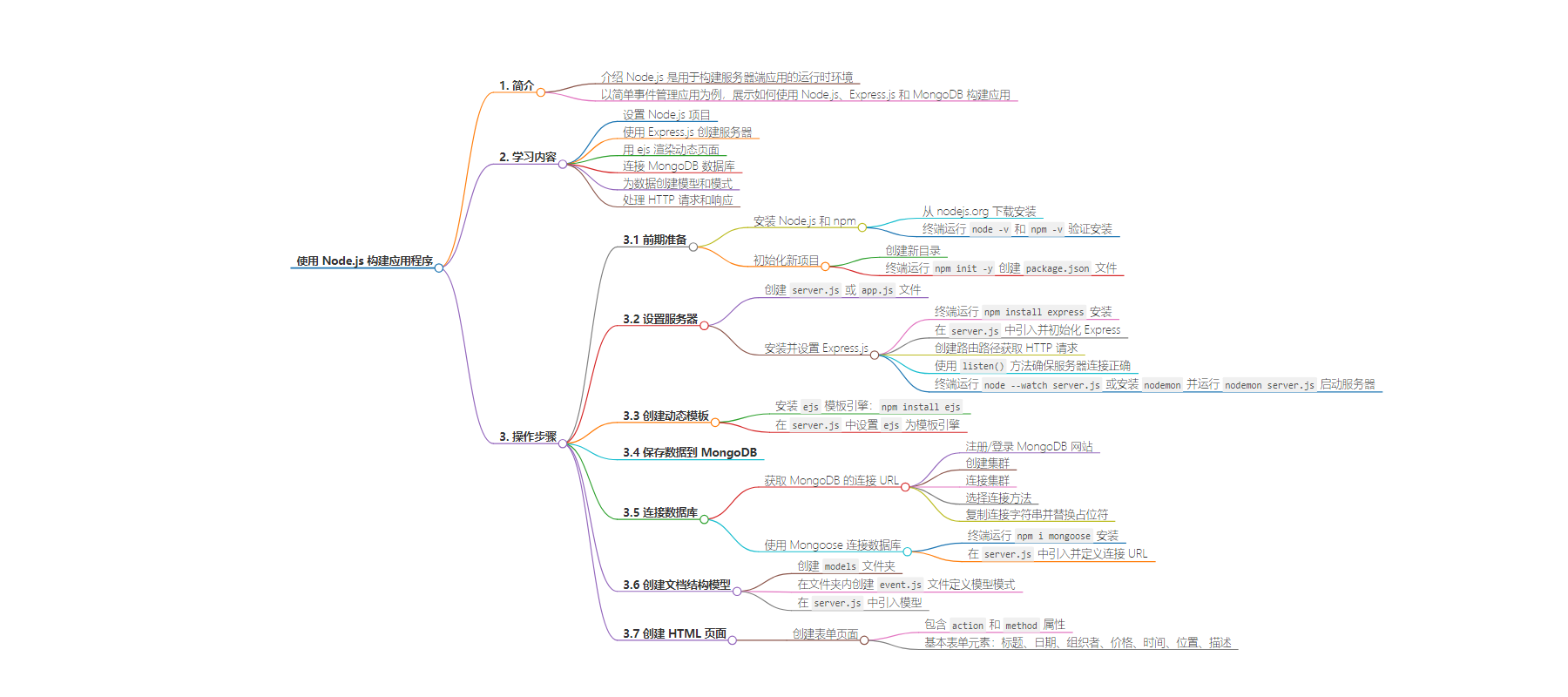
文章地址:https://www.freecodecamp.org/news/how-to-build-an-event-app-with-node-js/
文章来源:freecodecamp.org
作者:Ijeoma Igboagu
发布时间:2024/8/5 17:56
语言:英文
总字数:2819字
预计阅读时间:12分钟
评分:89分
标签:Node.js,Express.js,MongoDB,后端开发,JavaScript
以下为原文内容
本内容来源于用户推荐转载,旨在分享知识与观点,如有侵权请联系删除 联系邮箱 media@ilingban.com
Node.js it’s a runtime environment that allows you to run JavaScript code on the server side for building server-side applications. It works well for creating fast and scalable applications.
In this article, I will use a simple event management app as an example to show you how to build an application using Node.js, Express.js, and MongoDB.
By the end, you’ll know how to set up a Node.js project, create a server with Express.js, show dynamic pages with embedded JavaScript, and connect to a MongoDB database to handle your data.
What You’ll Learn
- Setting up a Node.js project
- Creating a server with Express.js
- Rendering dynamic pages with ejs
- Connecting to a MongoDB database
- Creating models and schemas for your data
- Handling HTTP requests and responses
Table of Contents
 Let’s get started 🚀
Let’s get started 🚀
Prerequisites
Step 1: Set Up Your Development Environment
Install Node.js and npm
First, you’ll need to download and install Node.js from nodejs.org. Then you can verify the installation by running: node -v and npm -v.
Initialize a New Project
Create a new directory for your project. Then initialize the project with npm: npm init -y in your terminal.
mkdir event-appcd event-appnpm init -y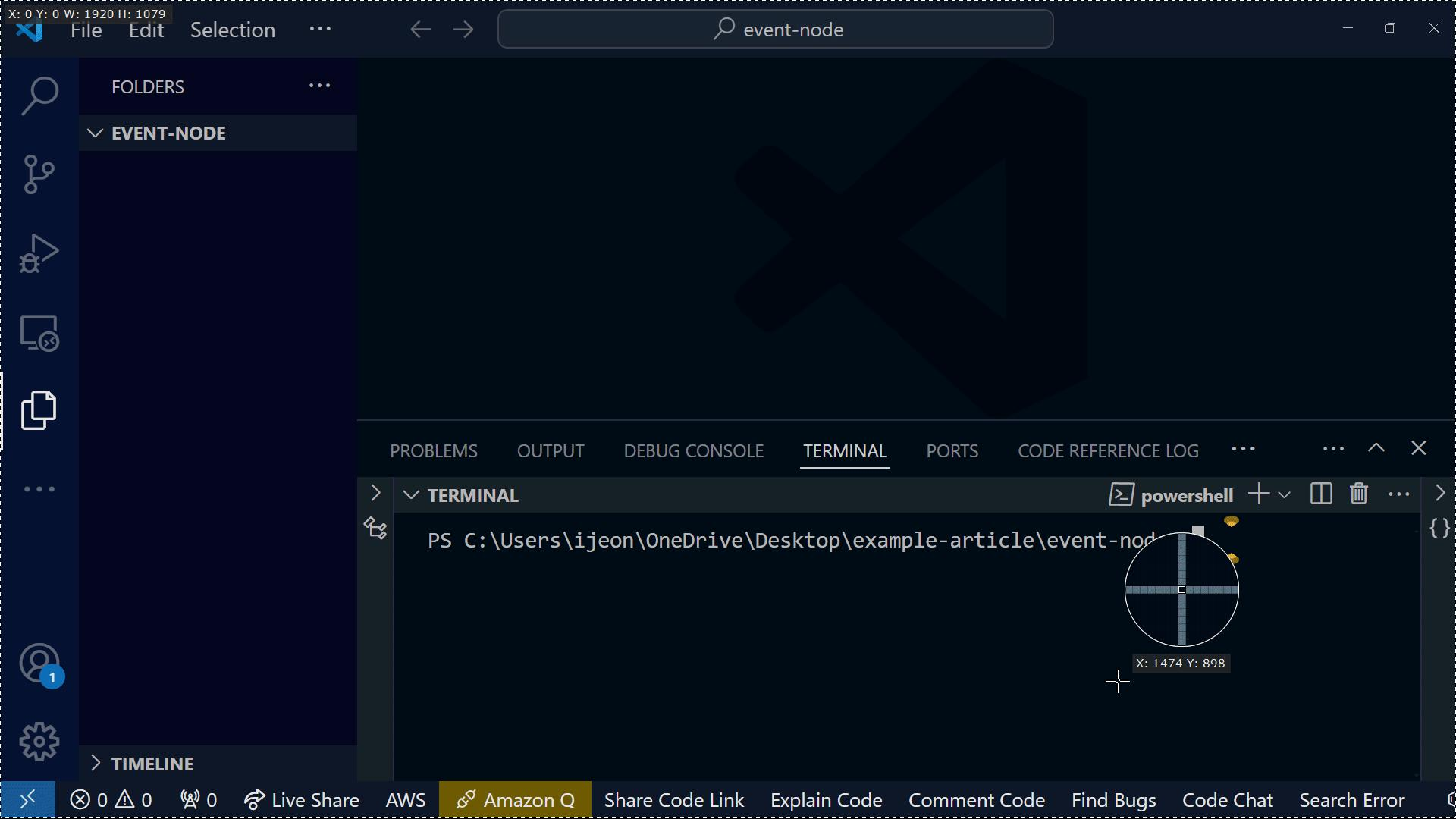 Initializing the project
Initializing the project
Running npm init -y creates the package.json file, as shown above. This file is crucial. It stores and tracks all third-party libraries (dependencies) needed for your application.
Step 2: Set Up the Server
To set up your server, create a file called server.js or app.js. These are common names. They are used for their descriptive nature. But, you can name the file whatever you prefer.
The server.js file will be used to create a server which will be used to manage, control, and route to the necessary page in our application.
Step 3: Install and Set Up Express.js
Express.js is a popular web application framework for Node.js and a third-party library that we use in our application.
Express simplifies the handling and definition of various routes for HTTP requests. It enables you to manage the application’s routing and connect it to the server.
To use Express:
Install Express.js by running the following command in your terminal:
npm install expressRequire Express in your server.js file.
const express = require('express')Initialize Express so you can use it in your application.
const app = express()Create a routing path to get the HTTP request.
app.get('/', (req, res) => { res.send('Hello World!');});Lastly, we need to ensure that the connection to the server is set up correctly. When we start the server in the terminal, it will open in the browser.
To do this, use the listen() method.
app.listen(3000, () => { console.log('Server started on port 3000');});This method will listen() to requests from the server.
Here’s the complete code process:
const express = require('express');const app = express();app.get('/', (req, res) => { res.send('Hello World!');});app.listen(3000, () => { console.log('Server started on port 3000');});Note: The routing path above was only for testing purposes to confirm that the server is working and connected. We will provide a different file for the event app we are creating.
With Express.js installed in your application, you can now create a server that will handle all your routing and connections.
To start the server, go to your terminal.
Use the keyword node, then type --watch, a flag to start and automatically restart the server whenever you make changes:
node --watch server.jsOr you can install [nodemon](https://www.npmjs.com/package/nodemon) for the same purpose. Nodemon detects changes in the directory and restarts your application.
npm install -g nodemonThen run your server with:
nodemon server.jsStep 4: Create a Dynamic Template
We need a templating engine to render HTML code in the browser using Node.js. We’ll use ejs (Embedded JavaScript) for this tutorial but there are others such as Pug (formerly known as Jade) and Express Handlebar, which also render HTML on the server.
ejs allows you to embed JavaScript in HTML to create dynamic web pages.
To install ejs, run:
npm install ejsTo set up ejs in server.js, require and set ejs as the templating engine:
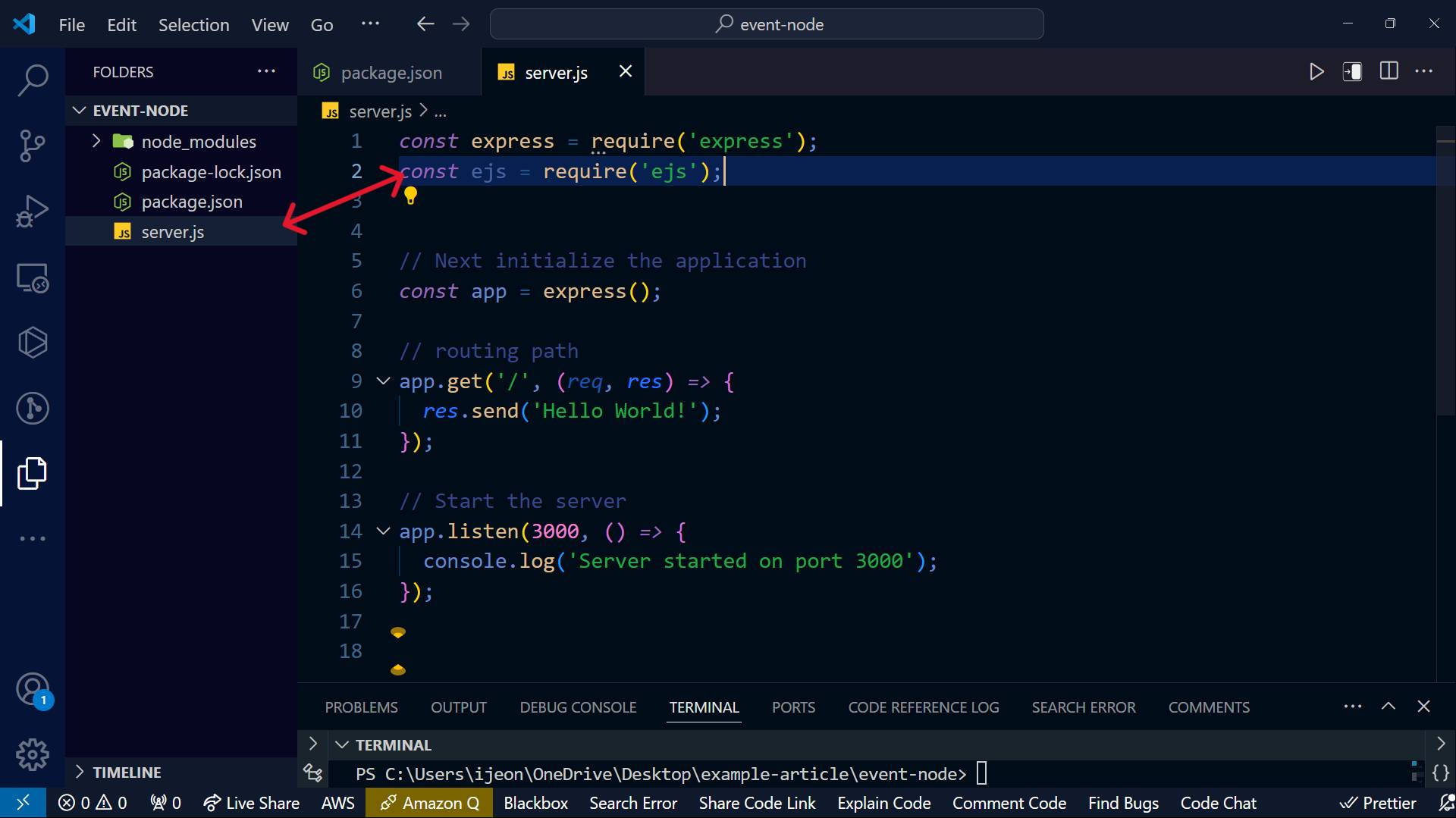 Requiring
Requiring ejs template in your application
const express = require('express');const app = express();app.set('view engine', 'ejs');With this setup, you can now enable dynamic rendering of HTML code in your Node.js application.
Step 5: Save Your Data to MongoDB
To save the data you create for your application, you will use MongoDB.
MongoDB is a “Not Only SQL” (NoSQL) database that’s designed for storing document collections. Traditional SQL databases organize data into tables, but MongoDB is optimised for handling large volumes of data.
To read more about this, check out this article.
Step 6: Connect to the Database
Now we need to connect to the database which will be MongoDB for this tutorial.
Using MongoDB provides you with a Uniform Resource Locator (URL) to connect to your application. This URL connect you and acts as a communicator between the database and your application.
How to get the URL
To get the URL, follow these simple steps:
- Sign Up/Log In: Go to the MongoDB website and sign up for an account or log in if you already have one.
- Create a Cluster: Once logged in, create a new cluster. This will set up your database.
- Connect to Your Cluster: After your cluster is created, click the “Connect” button.
- Choose a Connection Method: Select “Connect your application”.
- Copy the Connection String: MongoDB will provide a connection string (URL) like this:
mongodb+srv:- Replace the Placeholders: Replace
<username>,<password>, and<dbname>with your actual username, password, and database name.
Now that you have the URL, you can easily connect to your database.
To make this connection easier, we will use a tool called Mongoose.
What is Mongoose?
Mongoose is a JavaScript library that makes it easier to work with MongoDB in a Node.js environment. It provides a simple way to model your data. You can define schemas, do data validation, and build queries as well.
How to make a connection
MongoDB has already provided you with a URL for connection. Now you’ll use Mongoose to send your documents to the database.
To use Mongoose in your project, follow these steps:
Install Mongoose using npm.
npm i mongooseIn your server.js file, you need to require Mongoose to use it as a connector to the database.
const mongoose = require('mongoose');After you require Mongoose, you need to define the connection URl provided in your server.js file.
server.js:
const mongoose = require('mongoose');const dbURL = 'mongodb+srv://<username>:<password>@cluster0.mongodb.net/<dbname>?retryWrites=true&w=majority';mongoose .connect(process.env.dbURL) .then((result) => { console.log('Connected to MongoDB'); app.listen(3000, () => { console.log('Server started on port 3000'); }); }) .catch((err) => { console.error('Could not connect to MongoDB:', err); });This setup ensures that Mongoose acts as the connector. It connects your application to the MongoDB database.
Step 7: Create the Model for the Document Structure
Next, we need to create a model document called a Schema so that when you post data to your database it will be saved accordingly.
To create this model:
- Create a folder named
modelsto keep your application organized. - Inside the
model'sfolder, create a file calledevent.js.
In theevent.js file, you will use Mongoose to define the schema for the event documents. You’ll specify the structure and data types for the documents you will send to your database.
Here’s the event.js file created inside the model folder:
const mongoose = require('mongoose');const EventSchema = new mongoose.Schema( { title: { type: String, required: true, }, date: { type: Date, required: true, }, organizer: { type: String, required: true, }, price: { type: String, required: true, }, time: { type: String, required: true, }, location: { type: String, required: true, }, description: { type: String, required: true, }, }, { timestamps: true });const Event = mongoose.model('event', EventSchema);module.exports = Event;When this is done, export so you can use it in your server.js file by simply using the require keyword.
With the schema created, it can now be exported to the server.js file.
Your server.js will look like this:
const express = require('express');const ejs = require('ejs');const mongoose = require('mongoose');const Event = require('../models/Events');Step 8: Create HTML Pages
As we talked about earlier, we’re using ejs in step 4 to render HTML code, allowing us to view the code in the browser.
Form Page
First, let’s create a form page. With the form page created, you’ll be able to make POST requests which will enable you to send data to your MongoDB database.
To create a basic form, ensure it includes:
- An
actionattribute which specifies the route to send the data. - A
methodattribute which specifies the HTTP request method – in this case, the POST request.
A basic form:
<form action="/submit-event" method="POST"> <h2>Event Creation Form</h2> <label for="title">Title</label> <input type="text" id="title" name="title" required> <label for="date">Date</label> <input type="date" id="date" name="date" required> <label for="organizer">Organizer</label> <input type="text" id="organizer" name="organizer" required> <label for="price">Price</label> <input type="text" id="price" name="price" required> <label for="time">Time</label> <input type="text" id="time" name="time" required> <label for="location">Location</label> <input type="text" id="location" name="location" required> <label for="description">Description</label> <textarea id="description" name="description" rows="4" required></textarea> <button type="submit">Submit</button></form>NB: Make sure to add the name attribute to each input, or it won’t post.
The form created above will let you post data to the specified route. You will then process and store it in your database.
Here’s the result:
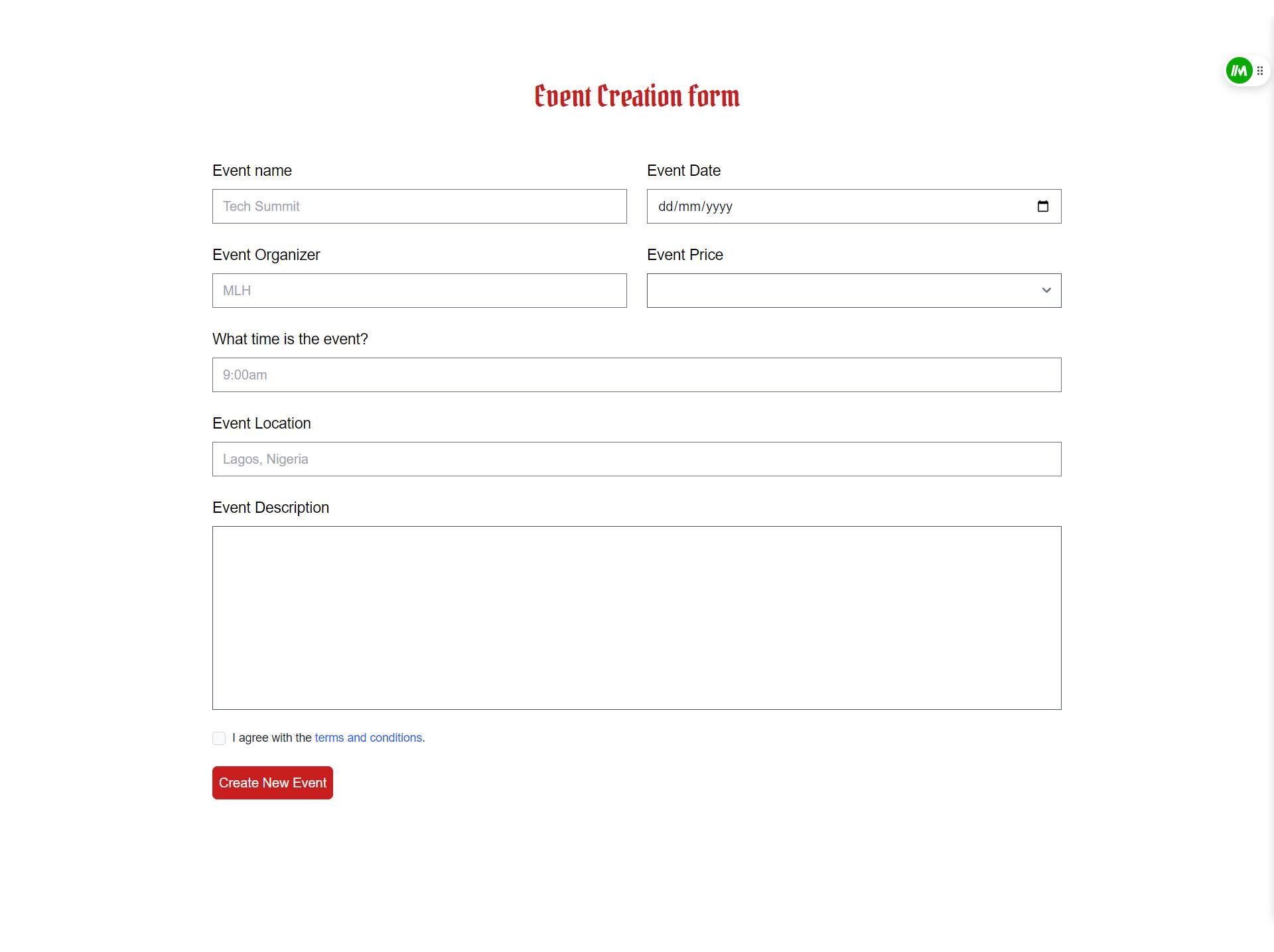 The form page
The form page
After creating the form page, we need to go back to the server.js file and create a POST request to handle the form submission.
server.js file:
app.post('/submit-event', (req, res) => { const event = new Event(req.body); event.save() .then((result) => { res.redirect('/'); }) .catch((err) => { console.error(err); });});The Homepage
Now that the form can post data to the database, we can create the homepage to display the created events in the browser.
First, in your server.js file, you need to create a function. It will fetch all the events posted from the form and stored in the database.
Here’s how to set it up:
This is a function created at server.js to fetch all data from the database:
router.get('/', (req, res) => { Event.find() .then((result) => { res.render('index', { title: 'All event', events: result }) }) .catch((err) => { console.error(err); })})Next, we will dynamically loop through each part using a forEach loop in the homepage file. Since we are using ejs, the HTML file extension will be .ejs.
<div> <h2>All events</h2> <div> <% if (events.length > 0) { %> <% events.forEach(event => { %> <div> <h3><%= event.title %></h3> <p><%= event.description %></p> <a href="/event/<%= event.id %>"> Read More </a> </div> <% }) %> <% } else { %> <p>No events available at the moment.</p> <% } %> </div></div>Here is an explanation of what each part of the code does:
- Heading (
<h2>All events</h2>): Displays “All events” as a heading. - Event List (
<div>): Container for displaying a list of events. - Conditional Check (
<% if (events.length > 0) { %> ... <% } else { %> ... <% } %>): Checks if there are any events (events.length > 0). If events exist, it loops through each event (events.forEach) to display its details. - For each event, it creates a
<div>containing the event’s title (event.title) in a<h3>tag, the event’s description (event.description) in a<p>tag, and a link (<a>) to view more details about the event (Read More). The link directs to/event/event.id, whereevent.idis the unique identifier of the event. - No Events Message (
<% } else { %> ... <% } %>): If no events are present (events.length <= 0), it displays a message saying “No events available at the moment.”
Step 9: Create Partials
Remember that you installed ejs into your application to facilitate more dynamic components. It allows you to break your code down further to be more dynamic.
To further organize your code, you’ll use something called Partials.
Partials let you break down your code into scalable, modular, and manageable parts, keeping your HTML organized.
First, let’s create a partial for the navbar.
How to Create a Partial:
- Inside your
viewsfolder, create a new folder namedpartials - Inside the
partialsfolder, create a new file callednav.ejs. - Cut out the navbar code from your homepage file and paste it into
nav.ejs.
Example:
First, create the Partials folder and file:
 nav partial
nav partial
Use the <%- include() %> syntax from ejs to include the nav.ejs partial across pages in your application where you want the navbar to appear.
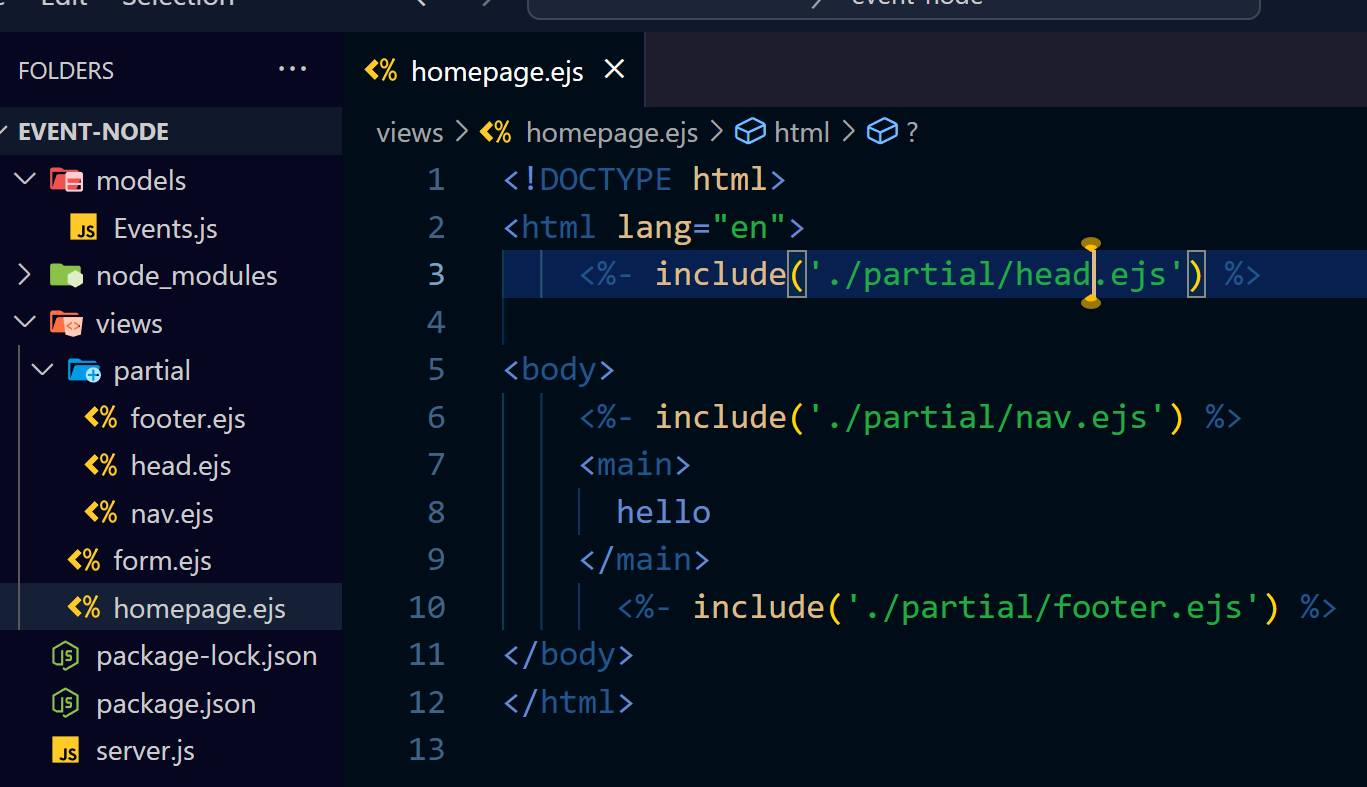 Include () syntax
Include () syntax
Here’s the code:
<!DOCTYPE html><html lang="en"> <%- include('./partial/head.ejs') %><body> <%- include('./partial/nav.ejs') %> <main> hello </main> <%- include('./partial/footer.ejs') %></body></html>With this setup, your HTML code will be organized. It will be easy to manage and update components like the navbar across different pages. You can use this approach on other parts of your application. For example, the head tag, footer tag, and other reusable components.
Step 10: Create an Environment Variable File (.Env)
In this tutorial, we’ll upload the project to GitHub. You’ll protect your port number and MongoDB URL with secure storage. You’ll also use an environment variable file, a configuration file known as .env. This file keeps sensitive information safe. It includes passwords and API URLs and prevents exposure.
Here’s how to set it up using Node.js:
First, install the [dotenv](https://www.npmjs.com/package/dotenv) package.
npm i dotenvThen create a .env file. Inside it, add your PORT number and MongoDB URL. It should look something like this:
PORT=3000dbURl='mongodb+srv://<username>:<password>@cluster0.mongodb.net/<dbname>?retryWrites=true&w=majority';Then update your .gitignore file:
/node_modules.envAdding .env to your .gitignore ensures that it is not included in your GitHub repository. This tells Git to ignore the .env file when uploading your code.
Then in your server.js file, require the dotenv package. Load the variables with this line at the top of the file:
To require it, simply type:
require('dotenv').config();This way, you don’t need to hardcode the PORT number and MongoDB URL in your server.js file. Instead, you can access them using process.env.PORT and process.env.dbURl.
So your server.js file will be cleaner and not messy 😵💫
require('dotenv').config();const express = require('express');const ejs = require('ejs');const mongoose = require('mongoose');mongoose .connect(process.env.dbURL) .then((result) => { console.log('Connected to MongoDB'); app.listen(3000, () => { console.log('Server started on port 3000'); }); }) .catch((err) => { console.error('Could not connect to MongoDB:', err); });Further Steps
To expand on this basic application, consider adding features such as:
- User authentication
- Event search and filter functionality
- Event editing and deletion
- Notifications for upcoming events
How to Style the Application
If you want to add some styling to your application, follow these steps:
First, create a public folder. Inside this folder, create a style.css file where you will write your custom CSS.
Then in your HTML file, link the style.css file in the <head> tag as you normally would:
<link rel="stylesheet" href="/style.css">To ensure your CSS file is served correctly, add the following line to your server.js file:
app.use(express.static('public'));This application uses Tailwind CSS for styling. But using Tailwind is optional. You can use any CSS framework or write custom CSS to achieve your desired layout.
How to Include Images
All images should be stored in the public folder and referenced in your HTML files. You should also ensure that the public folder is correctly set up in your server.js file to serve static files.
Here’s an example of how to serve static files in server.js:
const express = require('express');const app = express();app.use(express.static('public'));Conclusion
Congratulations! You’ve built a simple application using Node.js, Express.js, ejs, and MongoDB. With these fundamentals, you can expand and enhance your application to meet more specific needs and features.
Feel free to share your progress or ask questions if you encounter any issues.
If you found this article helpful, share it with others who may also find it interesting.
Stay updated with my projects by following me on Twitter, LinkedIn and GitHub
Thank you for reading 💖.
Happy coding!
